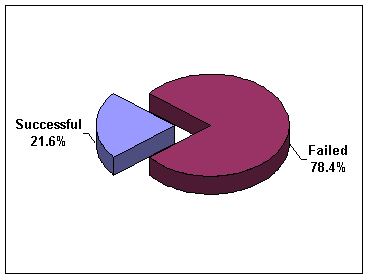Advanced Management Systems
- Over 20 years as your leader in
- case management software, systems, and support.
|
|
|
High Cost and High Failure Rates for Custom Application Development
Most managers have heard or experienced first hand the bottomless money pit of custom development. These projects can start out simple enough, but they never stay that way.
While the news will often report on the failed software development efforts of government agencies, that kind of attention is usually reserved for the loss of taxpayer dollars (e.g., software development losses in the millions at the California DMV). Fortunately, the Standish Group has done research on a variety of development efforts in the public and private sector for small and large projects. What are your chances of success? The Standish Group has completed surveys on custom development for several years. They have found approximately 8 out of 10 projects fail. Failed projects either were dropped before completion, or resulted in products with far less features than expected, took far longer, and went well over budget. Small projects were not immune... Many of the projects included in this research were not highly complicated, cutting edge technology. Projects were as mundane as a drivers license database, a new accounting package, and an order entry system. Plus, 48 % of the executives in the research felt that there are more failures currently than just 5 years ago. What return will you get on your investment? On average, even completed projects in this research had only approximately 42 % of the originally proposed features and functions. Estimates of the return on the development investment rarely consider the resulting software is likely to be 60 % less capable of saving staff time than originally planned. Lost Opportunity = Lost $... The losses in these failed projects go much further. Whether the project fails or not, with no application in place during the development cycle, further staff time is lost. The cost of not having an application in place is often overlooked during the design phase. Experience counts! Plus, whether you use internal staff or external consultants, most custom projects usually draw on only a handful of local managers in their initial design and ongoing development. Whether this experience is at the county or state level, it is rarely at the national level. On the other hand, DTAS delivers much more than software alone. You get the combined case management experience of literally thousands of experienced professionals working in the field nationwide and collected for over 20 years. This is a level of experience that not even the largest organizations can duplicate. Ongoing high cost of custom development... Even if you are one of the few that are successful, you must then contend with the high ongoing costs of customized software. While many mangers believe their costs will be concentrated in the building process, research shows that a good 70% of the overall cost of custom development comes after initial installation. For example, in Perspectives on Software Engineering, Marvin Zelkowitz from the Institute for Computer Sciences and Technology, National Bureau of Standards, Washington, D.C provides objective research evidence on the costs associated with custom development projects. While he breaks down the costs into several components, only 5 % of the cost is in design, and only 7 % is actual program coding. On the other hand, 15 % of the overall cost is spent on testing, and a significant 67 % of the costs occur after installation. Is it any wonder less than 10 % of managers today choose the path of custom contracted development, and only 30 % choose internal IT development, according to the highly respected Forrester Research, and those numbers have been shrinking every year.
|
Less than 10 % of managers choose custom development. This according to the highly respected Forrester Research. What can you expect from custom development?
|
| � Copyright 2010-2024 Advanced Management Systems, All Rights Reserved |

